I have just uploaded the first General Staff: Black Powder gameplay and artificial intelligence (AI) video. We will be publishing on Steam. Please feel free to contact me directly with any questions or comments.

I have just uploaded the first General Staff: Black Powder gameplay and artificial intelligence (AI) video. We will be publishing on Steam. Please feel free to contact me directly with any questions or comments.
I‘ve just uploaded a video of a walk-through of the General Staff: Black Powder Army Editor, Map Editor and Scenario Editor. These applications are completed. We will be using Steam for distribution. While we are registered with Steam, and they have given us ‘our space’, we still have to build it out and make arrangements for download keys for early backers. We (why do I keep using ‘we’, it’s just me here) truly appreciate your patience.
I will be posting a gameplay video of General Staff: Black Powder next. As always, please feel free to contact me directly.
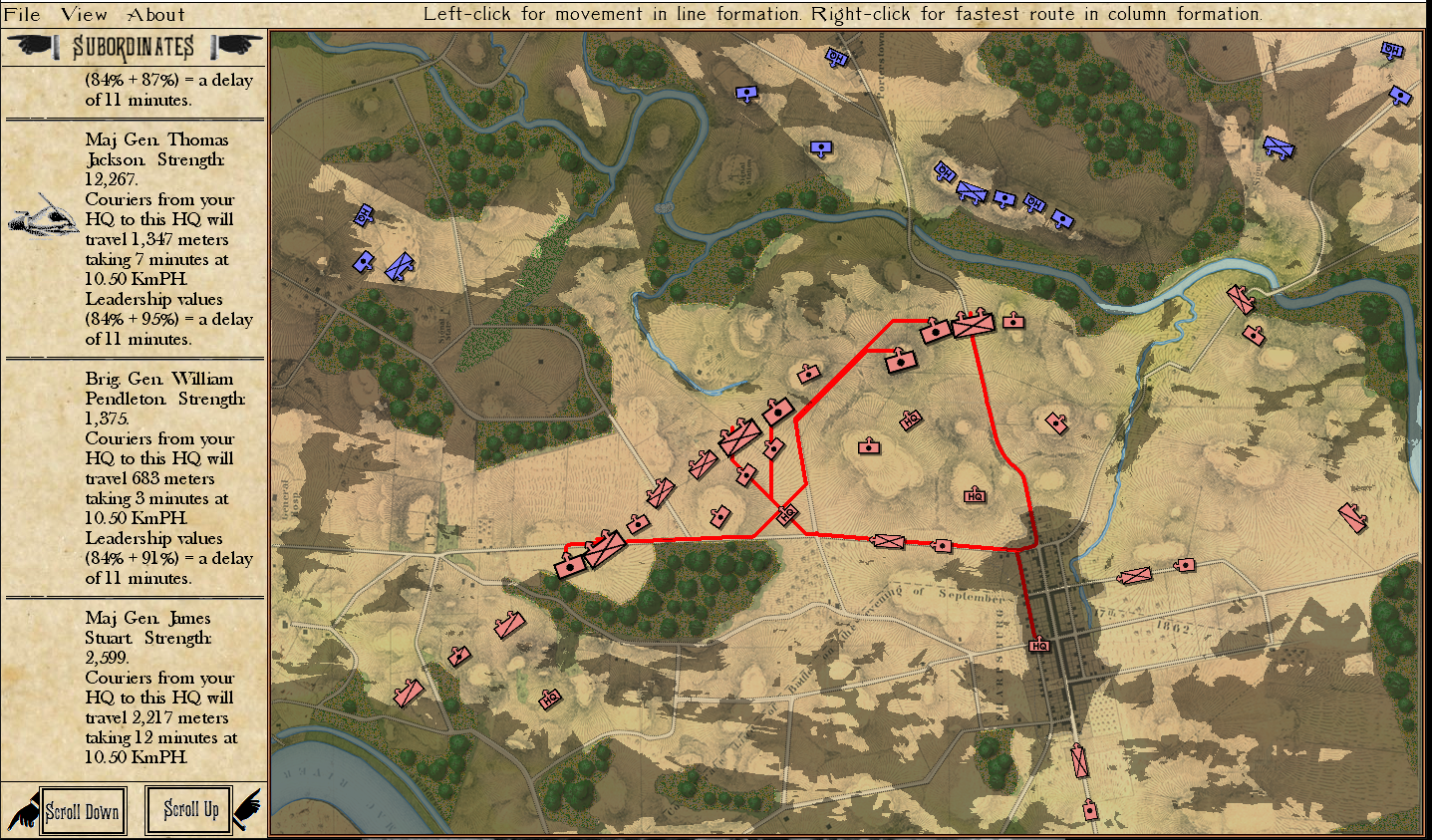
The delay in the transmittal of orders from headquarters and staff is one example of the Friction of War. Note the calculated time for couriers to arrive displayed in the Subordinate Orders list on the left of the screen. The red lines are the routes that couriers from General HQ to Corps HQ to individual units will take. General Staff: Black Powder screen shot. Click to enlarge.
Carl von Clausewitz, in has seminal work, On War, (Book 1, Chapter 7) originated the phrase, “Friction of War”:
“Friction is the only conception which, in a general way, corresponds to that which distinguishes real war from war on paper. The military machine, the army and all belonging to it, is in fact simple; and appears, on this account, easy to manage. But let us reflect that no part of it is in one piece, that it is composed entirely of individuals, each of which keeps up its own friction in all directions.”
I knew that if General Staff: Black Powder were to be an accurate simulation, and not just ‘war on paper’, that the friction of war would have to be calculated into the command / orders chain. One part of this – the distance the couriers will travel from one headquarters to the next to deliver their orders and the time it takes to travel this distance – can be calculated with reasonable certainty (I’m using the rate of 10.5 kilometers per hour for a horseman, I’m not an expert but this seemed reasonable, and it’s easy to change if somebody has a more accurate value).
Another example of friction of war is factored into the delaying of the arrival of orders is Leadership Value:
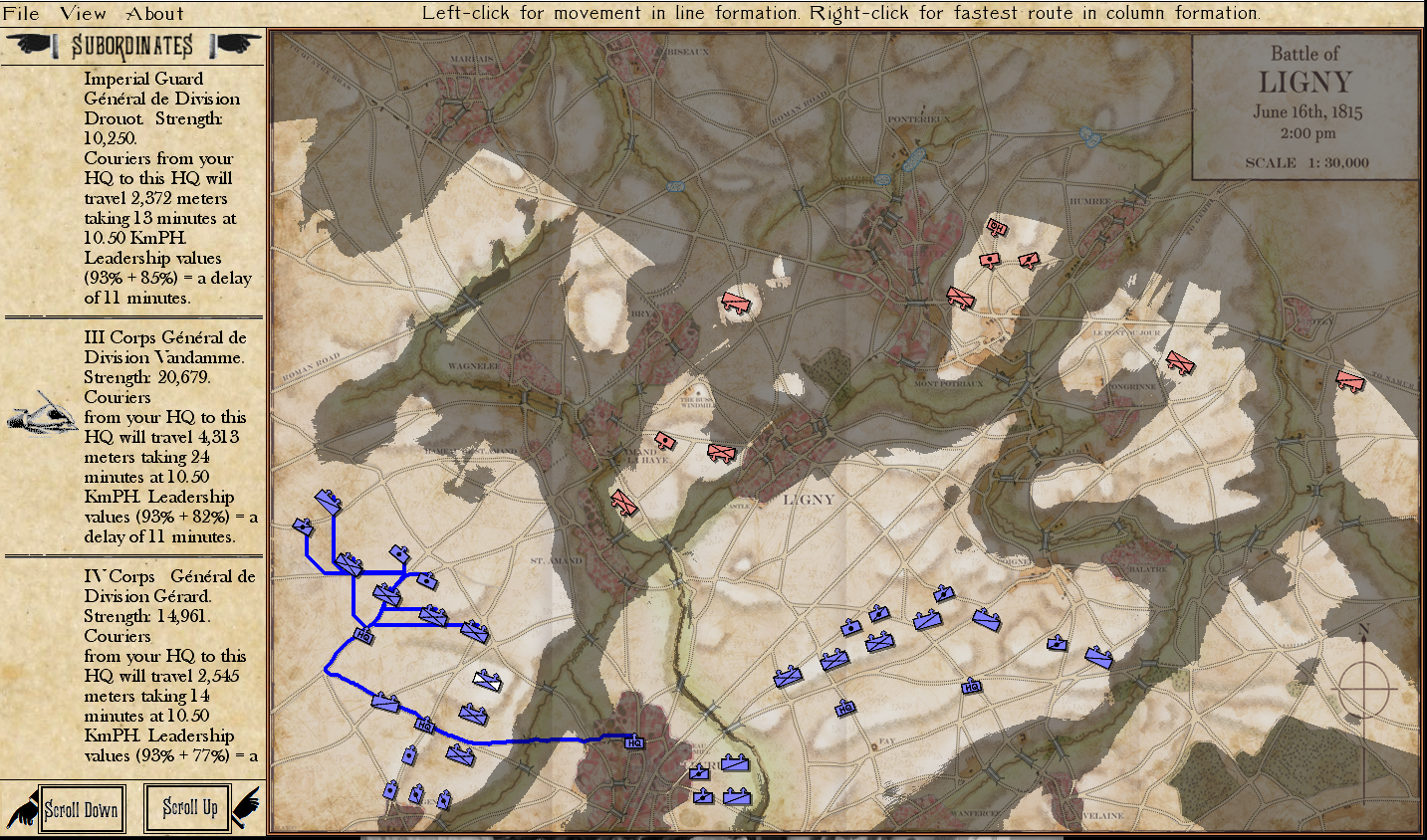
In this example, the Imperial couriers will travel over 4.3 kilometers, taking 24 minutes, to deliver their orders. Also, note the cost of the combined Leadership Values. Because Napoleon and Vandamme have very high Leadership Values little additional delay is added. General Staff: Black Powder screen shot. Click to enlarge.
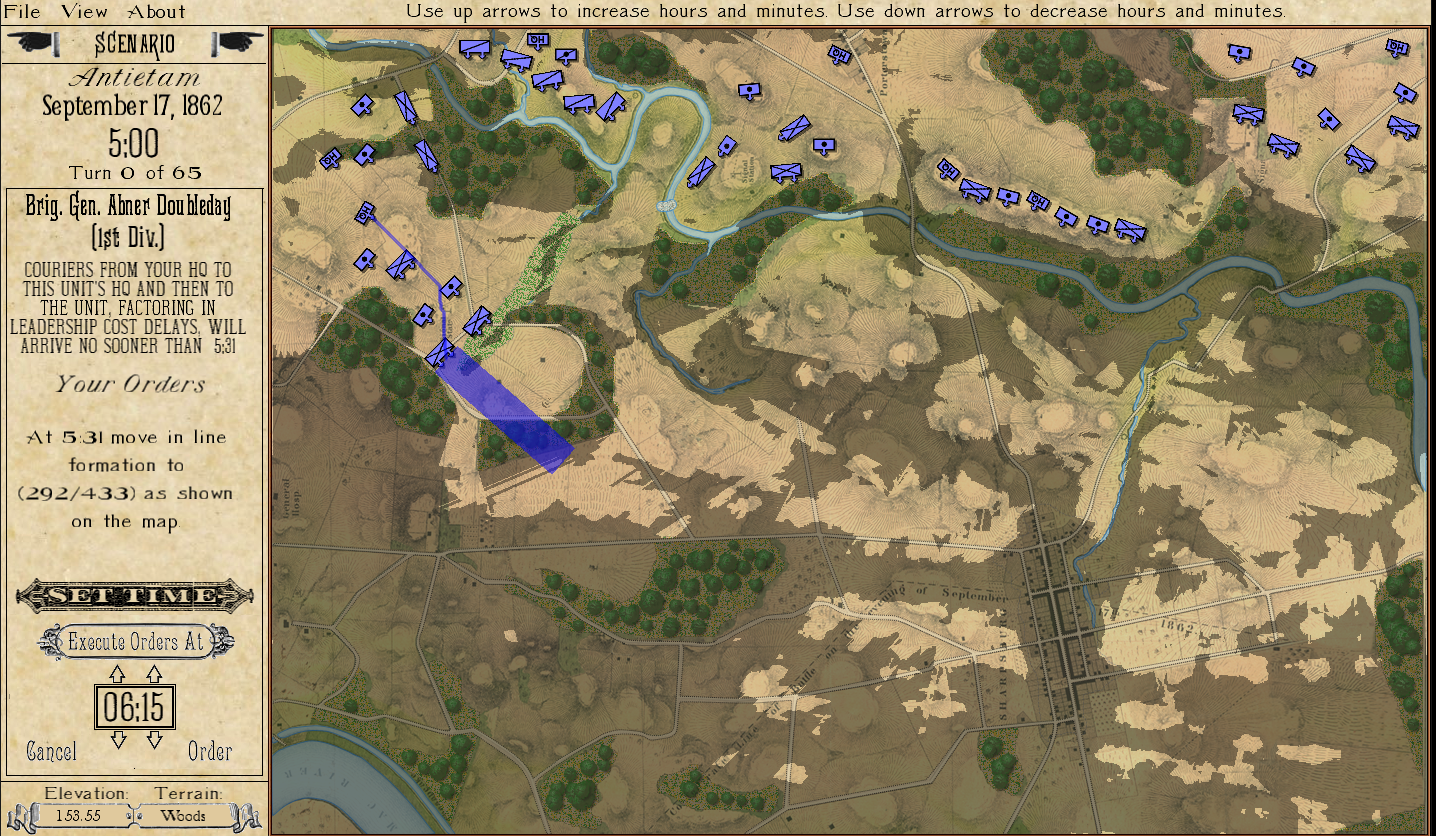
You can specify at what time the order is to be executed (in this case 6:15), however you can not set a time earlier than when the couriers would arrive. This allows for coordination of attacks across units. General Staff: Black Powder screen shot. Click to enlarge.
The other value – and it is arbitrarily set – is the cost of ineptitude, incompetence, lack of motivation, and sloppy staff work. In the above scenario (Ligny) Napoleon’s Leadership is set at 93%:

The slider adjusts Napoleon’s Leadership Value which effects the delay in issuing orders. General Staff: Black Powder Army Editor screen shot. Click to enlarge.
I understand that Napoleon may have been feeling a bit under the weather during the Hundred Days Campaign. You can set his Leadership Value to anything you want in the Army Editor (above).

Major General George B. McClellan’s Leadership Value can be changed in the Army Editor. Click to enlarge.
Did I set McClellan’s Leadership Value too low? He was amazingly incompetent. Note below:
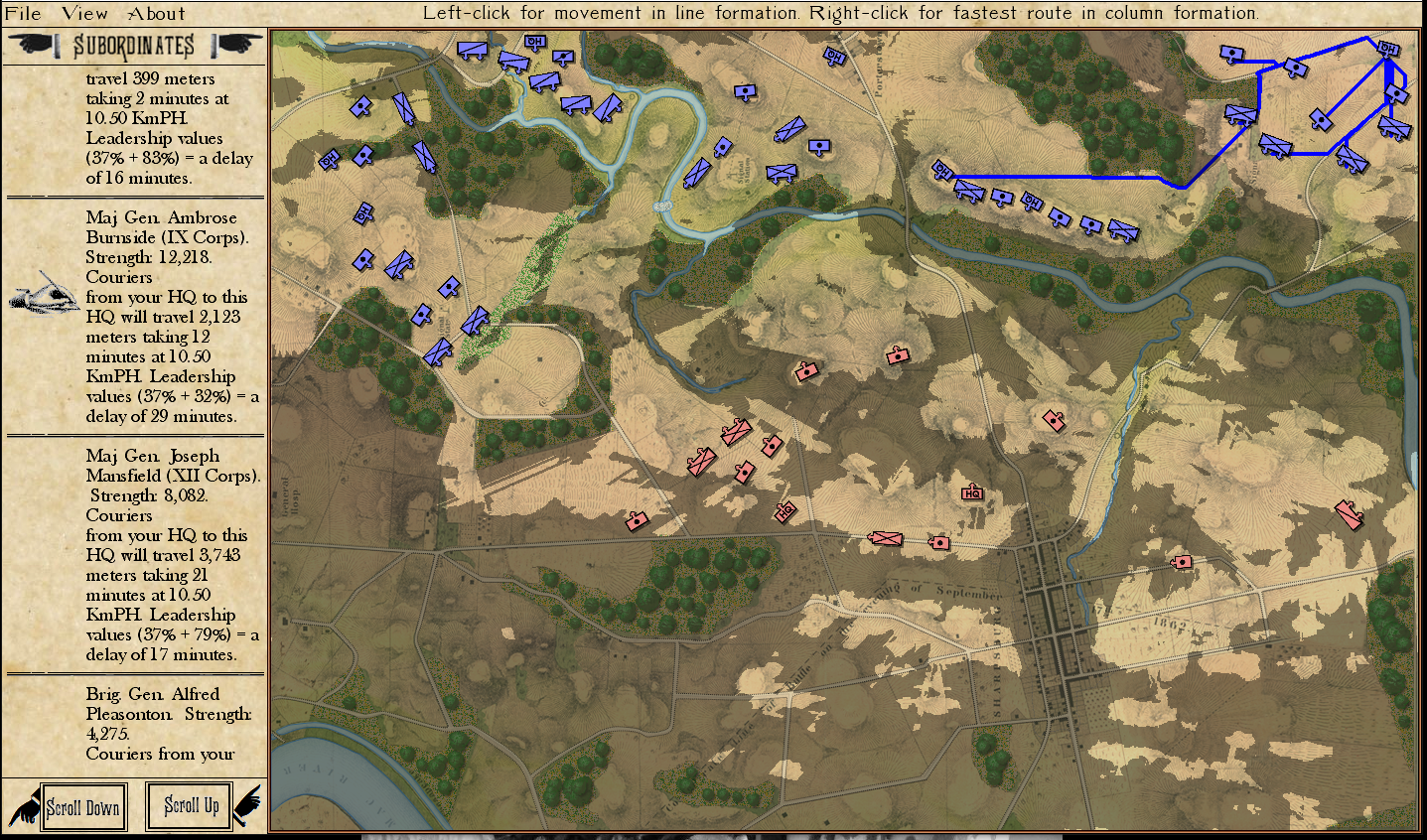
The combination of McClellan’s and Burnside’s extremely low Leadership Values adds an additional 29 minutes to the transmittal of orders. The blue lines trace the route that couriers would travel from McClellan’s headquarters to Burnside’s headquarters and then to each division and battery. General Staff: Black Powder screen shot. Click to enlarge.
The combination of McClellan’s and Ambrose Burnside’s Leadership Values results in almost a half hour delay in transmittal of the orders (remember after receipt of the orders, Burnside has to send couriers to his divisional and battery commanders, too and their Leadership Values effects the delay before their unit executes the order). After factoring the time it would take for a horseman to travel the distance between McClellan’s headquarters to Burnside’s headquarters (14 minutes) the earliest that a unit could be expected to respond to the original order from General Headquarters would be forty-one minutes later (and, in reality, a bit after that because of that unit’s Leadership Value).
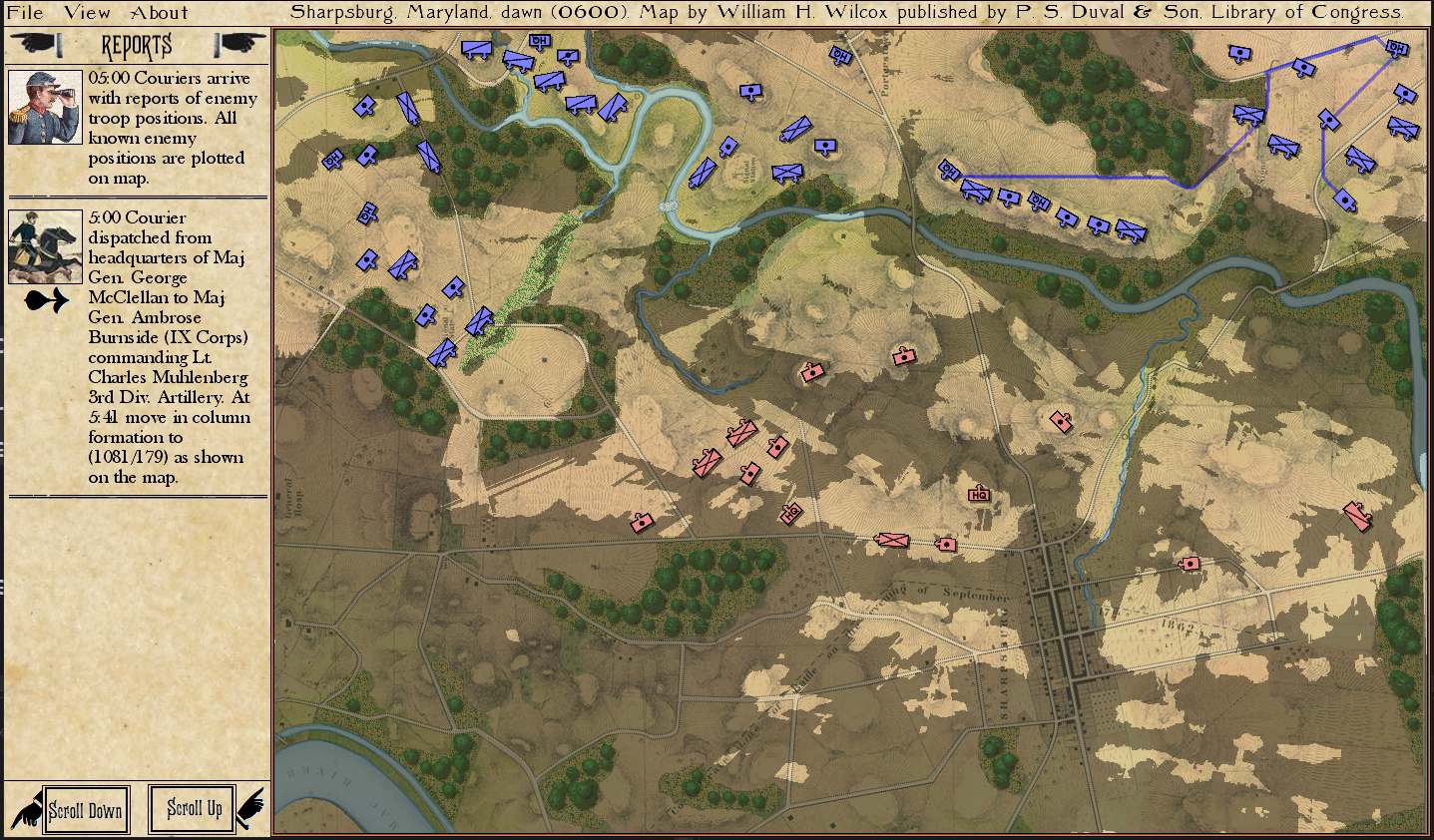
The path of the couriers from McClellan’s headquarters, to Burnside’s Headquarters and then out to the divisions and batteries. General Staff: Black Powder screen shot. Click to enlarge.
I have spent some time at Antietam and studied it at length and this delay of about three-quarters of an hour between the time McClellan wanted to issue an order and the men of Burnside’s IX Corps moved out seems if anything, too optimistic of a timetable. In fact, as I write this, I think I need to increase the penalty for poor Leadership Value. McClellan and Burnside couldn’t possibly have got units moving in less than an hour.
As I have begun playtesting General Staff: Black Powder I found the delay between issuing orders and wanting to see something move now was a bit disconcerting. It shouldn’t have been. I’ve read enough military history to know that battlefield orders were often transmitted the night before and moving units around during the battle could be a risky proposition. Some armies, however, were less afflicted with these problems than others, and that I would attribute to ‘leadership value’ which also encompasses the army’s general staff.
If you don’t want to use General Staff: Black Powder as a simulation that inserts a calculated delay between orders and execution, and would rather just move units instantly, there is ‘Game Mode’:
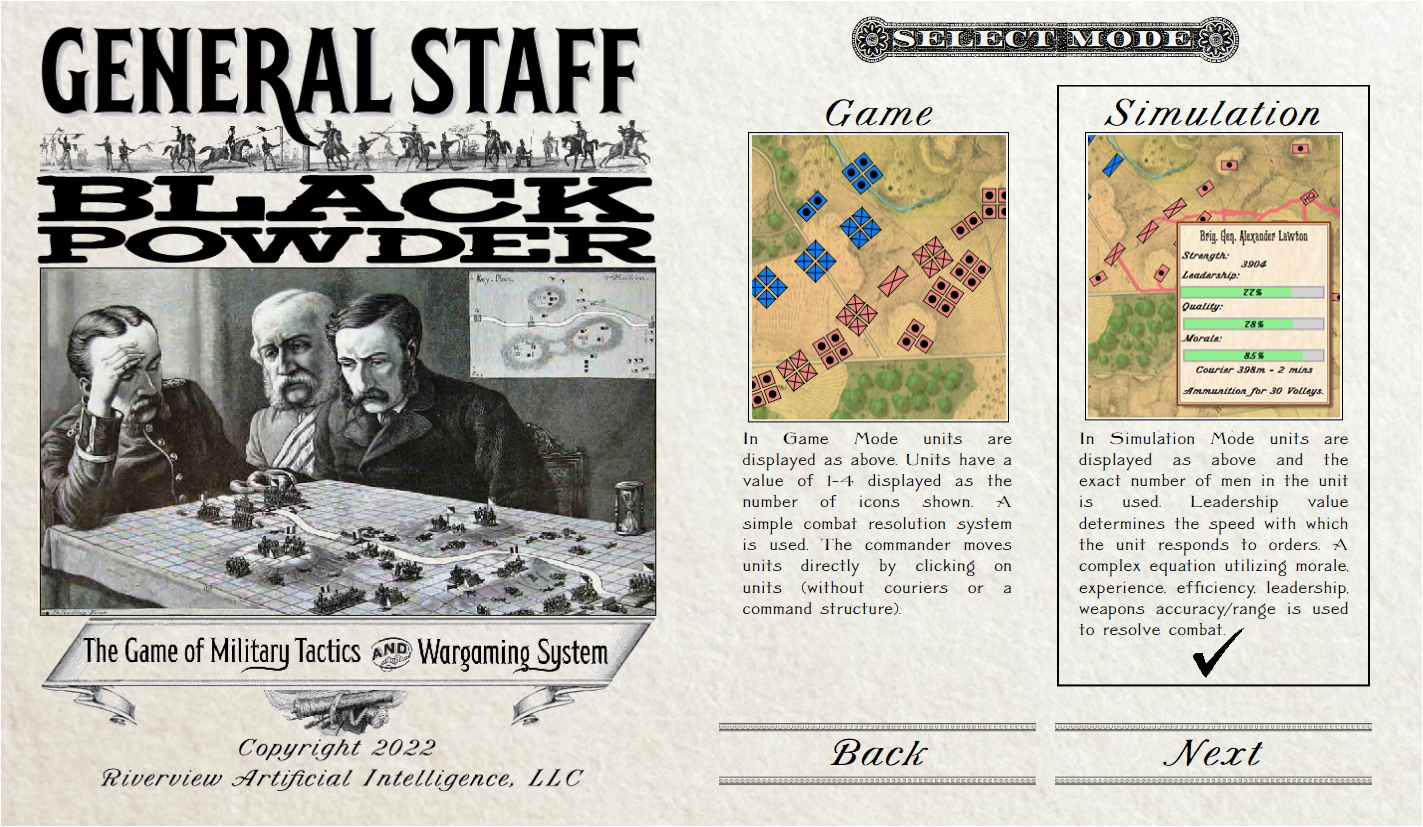
The Select Mode screen in General Staff: Black Powder. The user chooses between ‘game’ and ‘simulation’ with differences in rules and unit icons. Click to enlarge.
Game Mode has the same maps but uses simpler icons and rules. I originally envisioned Game Mode as a way of introducing wargaming to a new generation (I wanted to write it for the XBox). Anyway, it’s included with General Staff: Black Powder.
Lastly, I know everybody is waiting for news about when can I get my hands on the game?!!?!! My friend, Damien, wasn’t able to work on finishing it using Unity so I’m finishing it up using MonoGame. As you can see I’m pretty far along and I think I will be playing the first ‘actual game’ (that is a simulation from start to finish) within the next couple of weeks; maybe sooner. After that, probably at least another month of fixing bugs, but then I’m hoping to set up a Beta download for all the early backers via Steam. We have a space on Steam but I haven’t even begun to build it out. Obviously, I’m just one guy, I’m working as fast as I can, but I think this is all good news. Also, I’m working on a video to show everything off.
As always, if you have any questions or comments, please feel free to contact me directly.
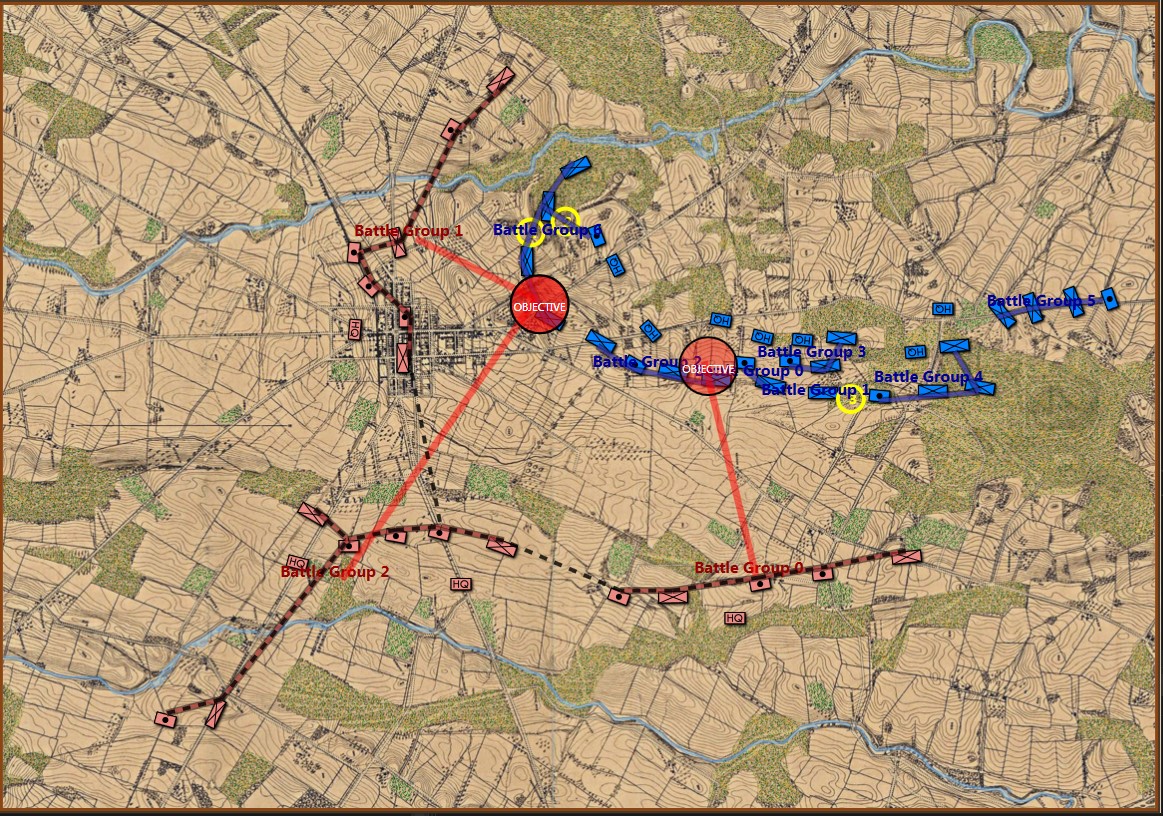
Screenshot of MATE analysis of Gettysburg, Day 3 from the Red (Confederate) position. Click to enlarge.,
General Lee, at Gettysburg, said: “the enemy have the advantage of us in a shorter and inside line and we are too much extended.” – quoted by Major General Isaac Trimble.1)Isaac Trimble, Southern Historical Society Papers, Vol. 26, Richmond, Virginia: Reverend J. William Jones, D.D., MATE, the AI behind General Staff, came to the exact same conclusion:

A portion of MATE’s analysis of Red’s position at Gettysburg, Day 3. Here MATE recognizes that Red has exterior lines and the enemy has a decided advantage.
I have been porting TIGER 2)Tactical Inference GenERator, the AI behind my doctoral thesis and my DARPA sponsored research from C++ to C# and integrating it into the General Staff: Black Powder wargaming system. I have been doing this via the method of first creating a scenario typifying a specific attribute (exterior lines, exposed flanks, choke points, etc.) and then porting the actual code over and feeding it the scenario for analysis. Gettysburg, Day 3, is the canonical example of exterior and interior lines.
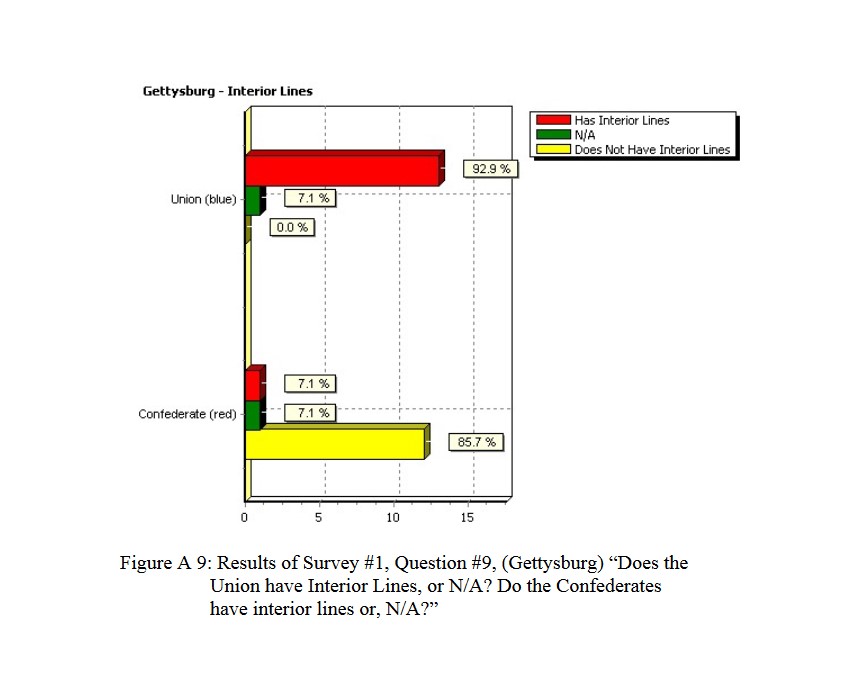
92.9% of Subject Matter Experts agree! The Union (Blue) lines at Gettysburg, Day 3, exhibit the attribute of being Interior Lines. Interior lines are good. Exterior lines are bad. From author’s doctoral thesis.
So, first a significant number of Subject Matter Experts (combat commanders, tactics instructors at military academies, etc.,) agree that there is an attribute called ‘Interior Lines’ and that it is exhibited by the Union (Blue) forces at Gettysburg, Day 3. We then create an algorithm that can detect such an attribute and convert it from C++ code to C# code (and substantially rewrite and improve said algorithm in the process) . We then create a Gettysburg, Day 3 scenario using the General Staff Army Editor, the General Staff Map Editor and the General Staff Scenario Editor and feed the scenario3)In Computer Science lingo programs are machines that consume data / tokens to MATE, the General Staff: Black Powder AI. These are the results:
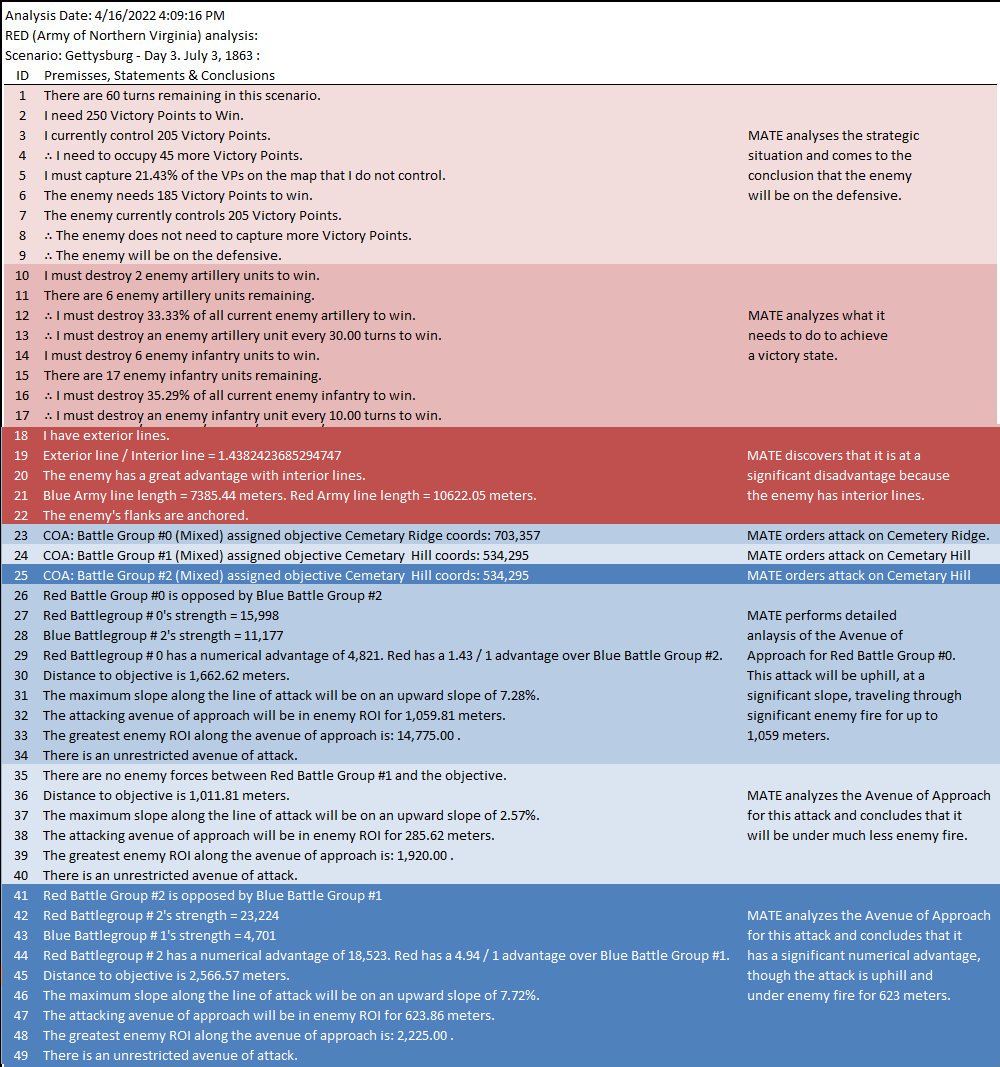
MATE analysis text output (with author’s commentary) of Gettysburg, Day 3, from the Red (Confederate) position. Click to enlarge.
The first time that I presented the Gettysburg, Day 3 scenario as Red to MATE it refused to attack. The enemy has interior lines (1.4, or 40% greater is pretty significant value), you’re attacking uphill (slope > 7%), your attacking units are under enemy ROI (mostly batteries of 12 lb. Napoleon canon shooting explosive shot and then canister and then double-shotted canister) for over a kilometer. Attacking is not a good idea. To get MATE to attack I had to go back to the Map Editor and create a number of new Victory Points; specifically the places where significant roads (Emmitsburg Road, Cashtown Road, Baltimore Pike, etc.) enter the map. Then I went in to the Scenario Editor and assigned appropriate values and current ‘ownership’. Saved it all and fed it back to MATE and the, above, is what I got.
The only way for MATE to win (as Red) is to attack large Victory Point areas (Cemetery Hill and Cemetery Ridge) and hope to destroy significant numbers of Blue (Union) forces along the way to meet the victory conditions set in the Scenario Editor:
Anybody who has built a wargame scenario (and I suspect there are more than a few among the readers of this blog) know the drill of going back to edit the OOBs, starting positions, victory conditions, etc. I would just like to say it’s pretty painless using the General Staff Wargaming System. The various editors all integrate seamlessly like Microsoft Office products (they were written in Microsoft WPF by Andy O’Neill who is a Microsoft Gold Developer).
But, the real question that this raises is: why did Lee attack on Gettysburg, Day 3? Blue (the Union) not only had interior lines, an elevated position, but they also had anchored flanks (see #22 above). MATE is running out of options at this point. If you look at the top screenshot you will see yellow numbers in yellow circles. These represent MATE’s three ‘weakest points’ in Blue’s line and it’s not much.
So why did Lee attack?
James Longstreet’s From Manassas to Appomattox states absolutely that
All that I could ask was that the policy of the campaign [Lee’s invasion of the north] should be one of defensive tactics, that we should work so as to force the enemy to attack us, in such good position as we might find in his own country, so well adapted to that purpose, – which might assure us of a grand triumph. To this he readily assented as an important and material adjunct to his general plan. [p. 331]
So, Longstreet, in his autobiography, is saying that Lee agreed that at some point in Pennsylvania, the Army of Northern Virginia would find a good solid defensive position and let Hooker (they didn’t yet know that Meade was the new commander of the Army of the Potomac) smash his army to pieces upon it. James McPherson in, To Conquer a Peace: Lee’s Goals in the Gettysburg Campaign writes:
“In a conversation with General Isaac Trimble on June 27, when most of the Army of Northern Virginia was at Chambersburg, Pa., and when Lee believed the enemy was still south of the Potomac, he told Trimble: “When they hear where we are, they will make forced marches…probably through Frederick, broken down with hunger and hard marching, strung out on a long line and much demoralized, when they come into Pennsylvania. I shall throw an overwhelming force on their advance, crush it, follow up the success, drive one corps back on another, and by successive repulses and surprises, before they can concentrate, create a panic and virtually destroy the army.” Then “the war will be over and we shall achieve the recognition of our independence.”
The argument is that Lee, on the morning of July 3, 1863, found himself in a terrible strategic situation with very few options. It was imperative that Lee must, “destroy the [enemy] army;” nothing less than a great triumph in enemy territory would do. In Lee’s only official report of the battle of Gettysburg, written on July 31, 1863 he states:
The enemy was driven through Gettysburg with heavy loss, including about 5,000 prisoners and several pieces of artillery. He retired to a high range of hills south and east of the town. The attack was not pressed that afternoon, the enemy’s force being unknown, and it being considered advisable to await the arrival of the rest of our troops. Orders were sent back to hasten their march, and, in the meantime, every effort was made to ascertain the numbers and position of the enemy, and find the most favorable point of attack. It had not been intended to fight a general battle at such a distance from our base, unless attacked by the enemy, but, finding ourselves unexpectedly confronted by the Federal Army, it became a matter of difficulty to withdraw through the mountains with our large trains. At the same time, the country was unfavorable for collecting supplies while in the presence of the enemy’s main body, as he was enabled to restrain our foraging parties by occupying the passes of the mountains with regular and local troops. A battle thus became in a measure, unavoidable. Encouraged by the successful issue of the engagement of the first day, and in view of the valuable results that would ensue from the defeat of the army of General Meade, it was thought advisable to renew the attack. . . .
Lee was in for a penny and in for a pound. This was not the defensive battle of Longstreet’s choosing. This was now Lee desperately trying to, “throw an overwhelming force on their advance, crush it, follow up the success, drive one corps back on another, and by successive repulses and surprises, before they can concentrate, create a panic and virtually destroy the army,” but now the enemy had, “retired to a high range of hills south and east of the town.” The Union had flipped Longstreet’s strategy 180 degrees and it was they who had, “force[d] the enemy to attack [them], in such good position as [they] might find.”
I will create some other Gettysburg scenarios including ones with the Union and Confederate cavalry available. While not historical, it might make for some interesting gameplay and Human-Level AI decisions.
As always, please feel free to contact me directly with comments.
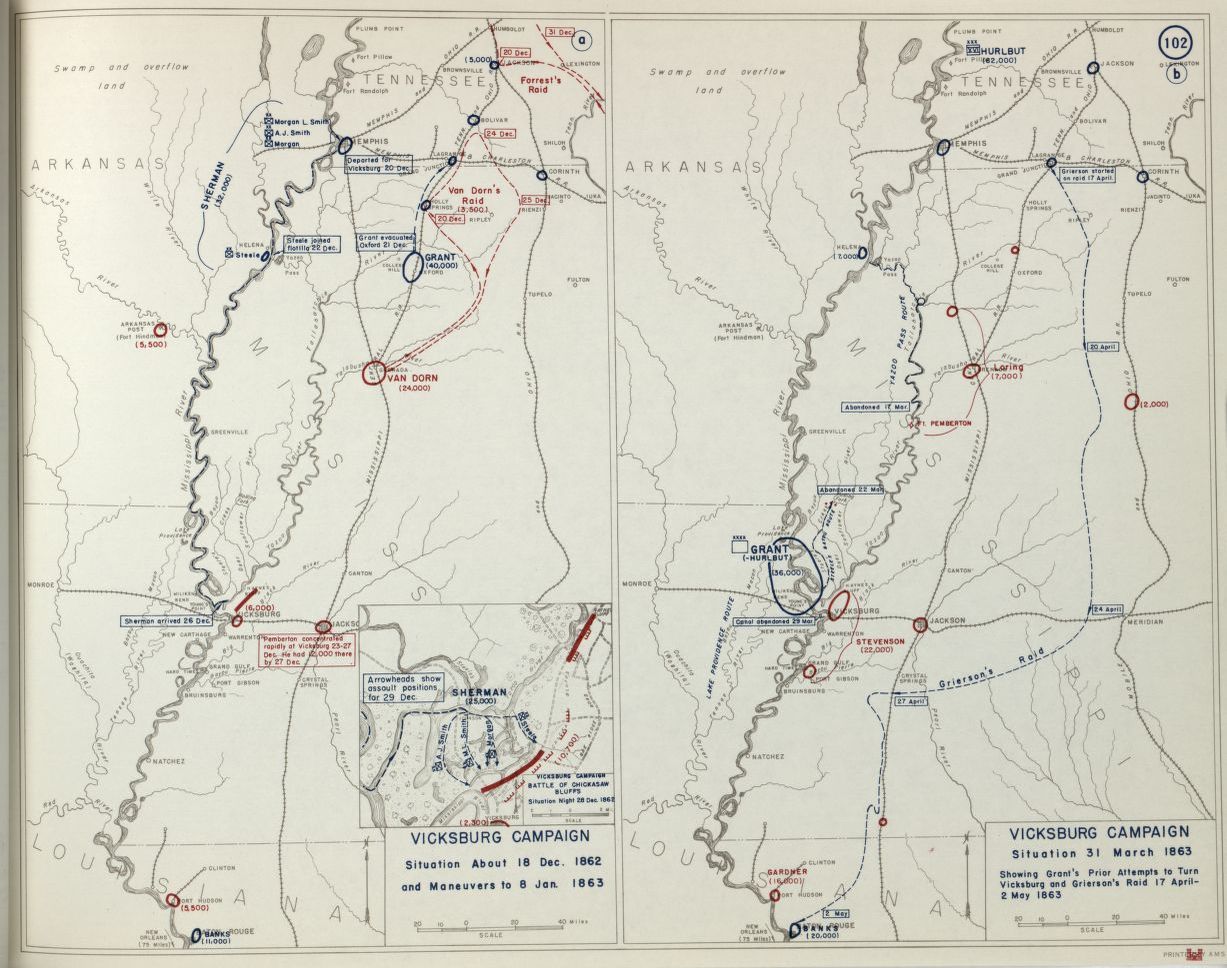
A few of Grant’s unsuccessful attempts to take Vicksburg. Map from West Point Atlas of American Wars. Library of Congress. Click to enlarge.
Grant took Vicksburg on his sixth attempt. He first tried a direct movement, east of the Mississippi, against the city but was forced to turn back after Confederate General Van Dorn’s raid destroyed his supply base. Sherman next attempted a direct assault and failed at Champion’s Bluff. Grant then tried to cut Vicksburg off from the Mississippi by digging a great canal across the neck of a giant oxbow. Unusually low water levels in the river that year caused another failure. Grant also tried more canal digging and river clearing at Lake Providence and the Yazoo Pass without luck.
Col. Theodore Lyman, a staff officer of the Army of the Potomac, wrote of Grant, “He habitually wears an expression as if he had determined to drive his head through a brick wall, and was about to do it. I have much confidence in him.”
Grant finally succeeded with his brilliant amphibious landing south of Vicksburg followed by a series of ‘must win’ battles that concluded with besieging the city on May 22, 1863. Confederate General Pemberton surrendered Vicksburg on July 4, 1863.![]()
The General Staff: Black Powder Wargaming System is comprised of four separate programs: the Army Editor, Map Editor, Scenario Editor and the actual Game Engine, itself. The first three have been done for some time (it’s what I use to produce scenarios for testing the AI). They were written in C# using Microsoft’s Windows Presentation Foundation (WPF) which is often used for creating desktop business applications. This decision made sense because the Army, Map and Scenario Editors function not unlike a suite of business applications that create and share data with a common look and feel. However, while WPF was a good development decision for the Editor programs it turned out not to be a great tool for creating the Game Engine.
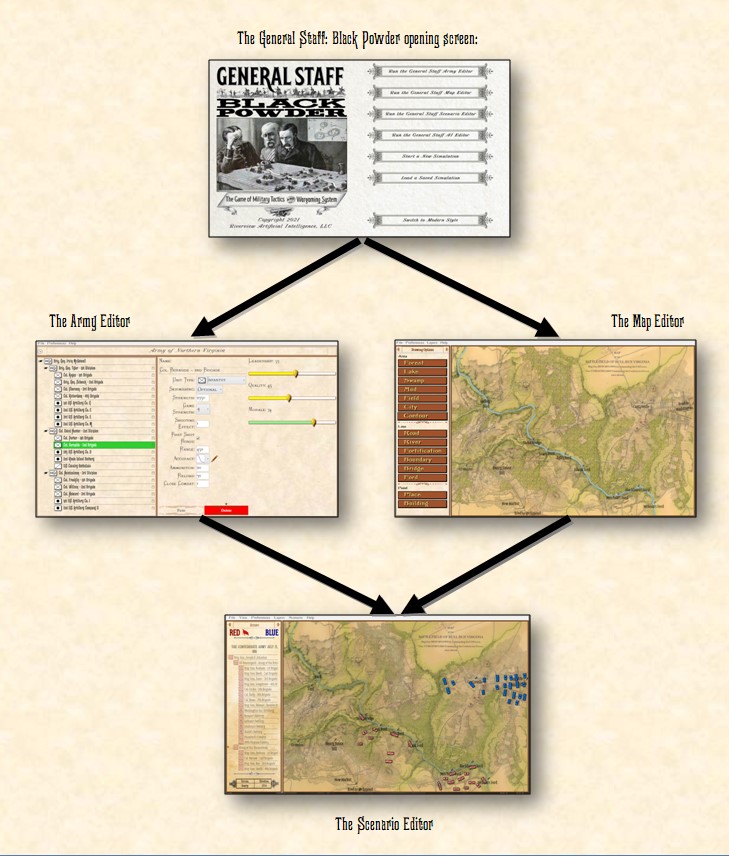
A flow chart of the General Staff: Black Powder Wargaming System. Files created in the Army Editor and the Map Editor are combined in the Scenario Editor to create a scenario or simulation. Click to enlarge.
What the Game Engine does is it takes data created in the three Editor programs, displays them in a visually exciting way, enables the user to make input (orders), and simulates those orders (as well as the AI’s orders) and the resulting combat to the highest degree of accuracy possible. That sounds like a lot, but it really isn’t. And the heavy lifting that the Game Engine is being asked to do is all visual: making everything look good on the screen.
Recently, I’ve been looking at Grand Tactician: Civil War which is an immersive voyage into 19th century American typography, cartography, tactics and grand strategy. I eagerly look forward to having the time to do more than gaze upon it in amazement 1)Full disclosure, the developers were kind enough to give me a review copy of Grand Tactician and, damn, it looks fantastic.. I reached out to Ilja on their development team and he convinced me that we should complete the General Staff Game Engine in Unity (which is what they used for Grand Tactician). What they accomplished visually with Grand Tactician was precisely the look and feel that I wanted for General Staff 2)I’m talking about the typography and the UI, not thousands of tiny 3D soldiers on the battlefield; which look really great, but, General Staff is not that kind of a wargame..
Consequently, we are officially announcing that we are abandoning writing the General Staff: Black Powder Game Engine in WPF and, instead, will be creating it using the Unity engine. We believe that this will produce a far superior visual experience 3)Please note: we will not being using Unity to create a 3D simulation with tiny soldiers. I like playing those kind of games, but that’s not what General Staff is..
Because Unity is designed to facilitate the creation of computer games, this move will greatly accelerate the completion of the General Staff Game Engine and will allow us to ship General Staff: Black Powder this year.
I am certainly not U. S. Grant, though I like to think I have some of that bulldog determination. Like Grant before Vicksburg, I’ve had to acknowledge that our first attempt will not succeed and we’re moving on to another plan. I am sorry for the delay in the release of General Staff and am confident that, with Unity, we will soon be reporting some good news.
![]() I am also very excited to announce that my good friend, Damien, will be joining the team to specifically work in Unity completing the General Staff Game Engine. Damien lives in Ireland and has been a devout wargamer since playing Arnhem on the ZX Spectrum. When not enjoying a Guinness or a Jamesons, he’ll be playing tabletop or computer games, whether that means pushing cardboard counters across hex boards, drawing LOS between badly painted miniatures on the tabletop, or day-long sessions in front of a computer – where he particularly enjoys playing against a challenging, non-cheating AI. Damien is a 28 year veteran of the IT industry, having worked on everything from telecoms, healthcare and financial systems, across Mainframes, Linux, Unix and Windows, and co-inventor of two messaging system patents. He has a particular passion for language processing and domain specific languages, originating from his interest in the elegance of recursive descent compiler construction.
I am also very excited to announce that my good friend, Damien, will be joining the team to specifically work in Unity completing the General Staff Game Engine. Damien lives in Ireland and has been a devout wargamer since playing Arnhem on the ZX Spectrum. When not enjoying a Guinness or a Jamesons, he’ll be playing tabletop or computer games, whether that means pushing cardboard counters across hex boards, drawing LOS between badly painted miniatures on the tabletop, or day-long sessions in front of a computer – where he particularly enjoys playing against a challenging, non-cheating AI. Damien is a 28 year veteran of the IT industry, having worked on everything from telecoms, healthcare and financial systems, across Mainframes, Linux, Unix and Windows, and co-inventor of two messaging system patents. He has a particular passion for language processing and domain specific languages, originating from his interest in the elegance of recursive descent compiler construction.
References
| ↑1 | Full disclosure, the developers were kind enough to give me a review copy of Grand Tactician and, damn, it looks fantastic. |
|---|---|
| ↑2 | I’m talking about the typography and the UI, not thousands of tiny 3D soldiers on the battlefield; which look really great, but, General Staff is not that kind of a wargame. |
| ↑3 | Please note: we will not being using Unity to create a 3D simulation with tiny soldiers. I like playing those kind of games, but that’s not what General Staff is. |